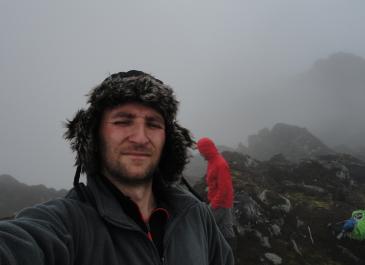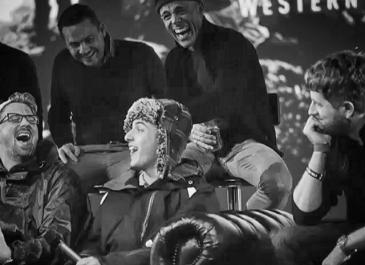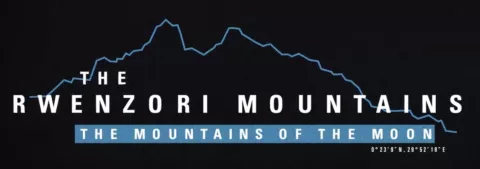Back in 2014 I had the pleasure of spending 11 days in Uganda.
At the time I was going through a divorce and knew it was going to be a difficult time with lots inwards reflexion so when the opportunity to fundraise for Compassion was presented at my Church I signed-up without really knowing what I was getting into.
Not only were we able to raise funds for a Water Project and see the impact this has amongst the communities but some of us got a chance to visit the children we had been sponsoring over the years. Getting to know their culture, their customs, their beautiful country and making strong friendships after all we endured over the 11 days we spent in together.
Our first amusement when we arrived was to be asked for our shoe size so we could get some rubber wellies for the trek as it has been the rainiest season they'd had for a very long time. But we had worn in our hiking boots and I had personally trained for months many times with my boots. I wore them non-stop for the previous 2 weeks to avoid blisters we could not imagine hiking in rubber wellies.
But by trek day 1 the damage of recent rainfall and the force of the swollen river was evident as it had taken half a village with it some weeks ago. The biggest irony of this trip to raise funds for the Water Project was that Rwrenzori translates to Lord of the Clouds!
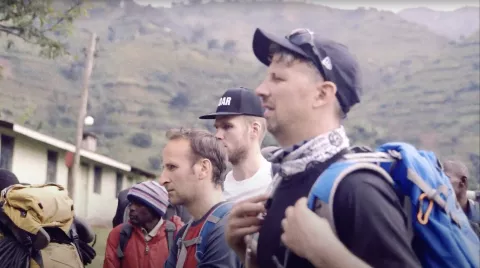
Overall the trek was much harder than we had anticipated but we managed to gather a rhythm and pace. Our porters were amazing and I distinctly remember one lady in her 50's shooting off never to be seen again.
The landscaped reminded me of the high and cold moorlands you find in Colombia. But given the rain it was also reminiscent of a scene from Lord of the Rings with kneed deep mud, bog and slush making your boots like suction pads while being threatened by sharp branches waiting for a mis-step to stab you.
The few stuck to their hiking boots regretted it. There's nothing worse than wet boots and not clever gaffa tape worked.
But being able to arrive at our overnight campsite which our porters had got ready with hot drinks and food was an incredible detail and daily encouragement. By night 4 many were already popping high altitude tablets to subdue the side effects. I think my many years living in Colombia meant it did not affect me as much.
Summit Day
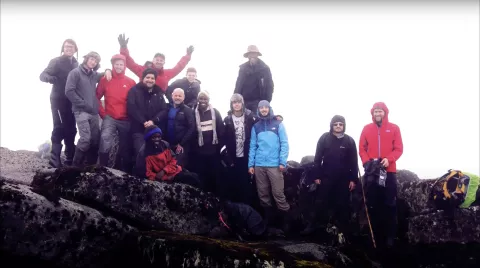
The day we'd been awaiting for so long. It was a very early rise to catch the privileged view over lake Bugata but it was also going to be our longest, most difficult and coldest. It was a slug and personally for me quite emotional as I spent time thinking about my two kids and the future.
I honestly barely make the summit to Weismann’s Peak at 4,620masl and the weather condition were far from ideal. But with much encouragement from all those who by now we all considered friends, 11 out of 12 of us make it to the summit. There was only really time for a quick photo, catching our breath and some time to meditate before heading back down.
We now had 2 days to climb down what had just taken us 4 days to climb up. I was very blessed to have an amazing guide which I stuck very close to. He was a human goat who danced lightly springing down at speed. It felt like a dance where I had to keep close for every step to keep the rhythm and momentum with agility but with strong concentration.
Not only was this hike an adventure but it also an opportunity to heal at a tumultuous time in my life. This has inspired me in many areas of life and given me a passion for hiking.
Our friend Lincoln had the pleasure of not only having to carry camera gear but also have to get ahead of us to take the footage so he had it much worse than us. Fortunately he's got long legs and here is the resulting video:
Bonus: Queen Elizabeth National Park
Our hosts were incredible and managed to arrange an additional visit to this game reserve which I highly recommend. So we had a stunning sunrise topped up with lions, hippos, elephants and more...
Full Trek Itinerary
Day 3 / Trek Day 1
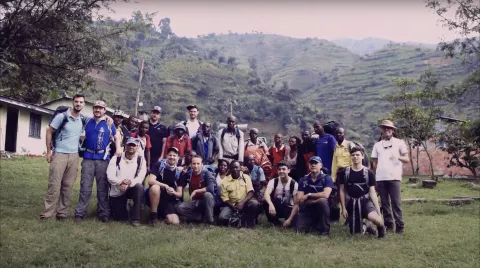
The trek starts around 10:30 at Trekkers Hostel in Kyanjuki, which is situated 1,450masl and 12km from Kasese. You walk 2.2km to the UWA rangers post at 1,727masl which takes about one hour. Here you pay the gate entrance fee and the rangers brief you on the rules of the National Park. We start by walking up the valley floor through tall forest trees of the Afro Montane Forest Zone. This is a steady climb with multitudes of birds and a chance of seeing a wild chimpanzee or blue monkey scampering off through the forest. At times visitors see troupes of 15 to 20 Colobus monkeys scampering through the tree tops. There are rare sightings of the L’Hoest monkey which are part of the Bukonzo cultural emblems and are protected by the virtue of the King or Omusinga. There is wide variety of plant species from forest trees to bamboos thickets, low shrubs, flowers, fungi, and with many moss and lichen covered vines hanging from the tall trees creating an awesome appeal. Enock’s Falls are just 200m from the day’s camp at Sine Hut (2,585masl) and offer a splendid opportunity to capture a great screensaver for your memories. The wooden hut is a set between tall forest trees on a narrow ridge, where you may sit and enjoy the beauty of the Afro Montane forest while you look down at a fantastic waterfall crashing over the rocks far below. Sine is just below the bamboo zone and the area around has many different bird species.
Day 4 / Trek Day 2
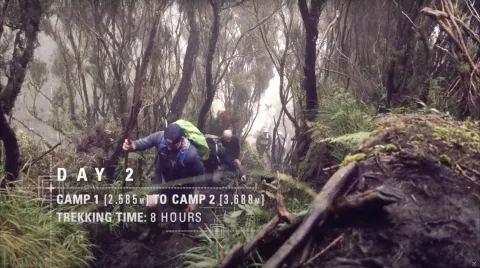
After a good breakfast, trekking starts at 8.30am and you soon enter the Bamboo-Mimulopsis zone which is steep climb with many high steps. In the wet season the bamboo area is rather muddy and slippery making the going slow. However the atmosphere and the forest is beautiful as you climb 551m in altitude and a distance of 1.8km to Kalalama Camp at 3,147masl which is in the Heather-Rapanea zone where you can take a rest and a quick cup of tea or coffee before heading on to Mutinda Camp. The trail meanders up and over several small knolls along a ridge top then drops down the side of the valley before climbing again, and in doing so cross several small streams and passing close to moss covered waterfalls. You then climb steadily along the side of a beautiful mossy river which tumbles down over the rocks under the Giant Heather trees whose trunks are covered in green moss with old man beards (Usnea lichen) hanging from the branches. The trail twists and turns as you climb up the deep valley, which has an enormous variety of plants and flowers. This valley is unique with many giant heather trees creating a beautiful atmosphere often shrouded in mist. Eventually you get to Mutinda Camp which is set near a small river that drops off a waterfall and offers a chance to wash, refresh and relax or, you may wish to climb up to the top of the Mutinda Lookout (one and a half hours up and one hour down). The view and the atmosphere is amazing as you stand on moss covered rocks at 3,925masl with views across the Rwenzori Mountains, down to Kasese town and Lake George.
Day 5 / Trek Day 3
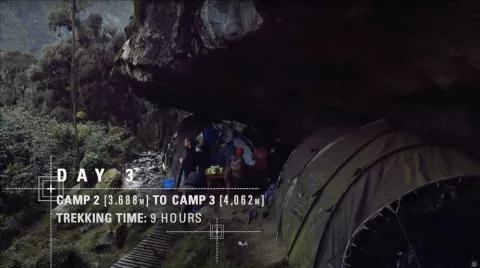
4.9km starting at 3,688masl climbing to 4,062masl. The trail here is boggy - particularly in the wet season - but with a little skill you can step from tussock to tussock to make the going easier. You cross the Mutinda valley through the tussock grass and everlasting flowers interspersed with many Giant Lobelias before climbing a steep section up to the Namusangi Valley (3,840m), which ends abruptly with sheer waterfalls and fantastic views of Mutinda Peaks. The Namusangi Valley is wide, with many ups and downs and crossing several bogs as the trail climbs steadily to Bugata Camp at 4,062masl. Bugata Camp is situated way up Bamwanjara Pass high above Bugata Lake with views across Lake Kopello to Weismann’s Peak, (which is often covered with snow), and of Lake Africa and Kanganyika, and the many small peaks towards Mutinda Camp. The area is covered with tussock grass, everlasting flowers (Helichrysum), St John’s Wort (Hypericum becquaeritii), giant groundsel (Senecio adnivalis) and Giant lobelia (Lobellia gibberoa). There are a many Red Forest Duiker (Cephalophuc nigrifrons rubidus) which are a sub-species only found in the Rwenzori Mountains. In the past they have been very hard to see due to the thick vegetation but since the fire, which burnt across the alpine region of the Rwenzori Mountains, they are now easier to see in the new shorter growth. In the dryer season you may choose to walk directly up the valley but a more scenic trail meanders along the hilltops with fantastic views of Lake Nusuranja from Plozza Rock. From Plozza Rock you also get fantastic views down the valley of nine lakes ringed by rugged peaks and ridges. Bugata Camp has good facilities, solar lights, good toilets and bathrooms where the guides may prepare some warm water in a basin for you to wash.
Day 6 / Trek Day 4
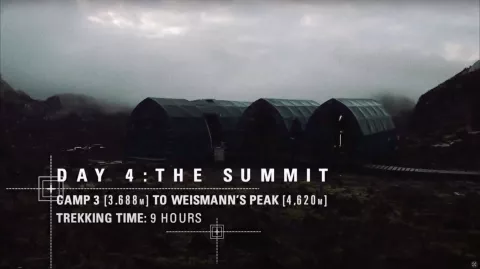
Today includes the climb to Weismann’s Peak at 4,620masl and Stella Peak at 4,626masl – a total distance of 9km in 4 to 6 hours. The trek starts by walking across the hillside below high cliffs above Bugata Lake then around a ridge point to Lake Kopello where we walk along the edge of the lake which according to researchers the water temperature averages 2˚C. As you climb you get excellent views of the four lakes along the valley below. The last section to the peak is steep on solid rock and can be difficult when snowing or iced up and it may be necessary to use ropes for safety. On a clear day you get fantastic views of all the main peaks, Mt Stanley, Mt Speke and Mt Baker. The top of Weismann’s Peak is relativity flat or dome shaped with deep moss growing on the rocks creating a beautiful atmosphere. For those who want to climb the highest point we can take a gentle walk across the moss covered domed shaped ridge to Stella Peak 4,626masl. Return to Bugata Camp.
Day 7 / Trek Day 5
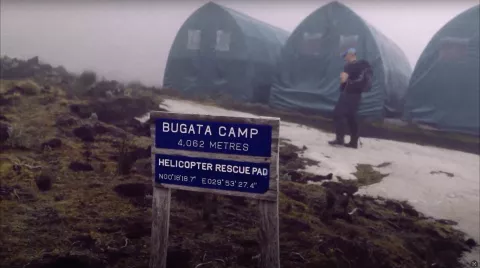
Early morning set off around Lake Bugata and the outlet of Kopello Lake then climb 200m to the confluence of the two valleys . As you descend down the upper areas of the Nyamwamba Valley there is a large area of thick Giant Groundsel with dense evergreen undergrowth and moss with the rocky peaks towering above. As you descend the valley you will notice the terrain is made up of several flat boggy areas where millions of years ago glaciers sat and melted leaving a wall of big rocks in front of where it lay. The valley is home to many Red Forest Duiker (Cephalophuc nigrifrons rubidus). At night you may stay either at Kiharo Camp at 3,460m and enjoy the lush vegetation and rocky cliffs, or may descend to Samalira Camp at 3,170masl which in turn results in a shorter trek down to base camp the following day.
Day 8 / Trek Day 6
After a hearty breakfast you walk down the valley which is home to many species of birds who dive in and out the thick vegetation. Chameleons are a common sight as they crawl along the branches of the thick vegetation feeding on insects. In the clear areas you may catch a glimpse of a Duiker quietly feeding surrounded by Giant Lobellias and a variety of flowering plants. After descending a few kilometres you climb 200m height to a ridge overlooking the valley before crossing several small valleys and streams to Kyalavula which means view or lookout in the local Bakonzo language with beautiful views down the valley and across to Lake Edward in Queen Elisabeth National Park. From here you descend down a long ridge, through the Bamboo-Mimulopsis Zone and Afro Montane Forest Zone back down to base camp in Kilembe – with a likely arrival time around 1pm dependent on the pace of the group. From here, you will be collected and returned to Kasese for rest, relaxation, dinner and overnight at the hotel.
